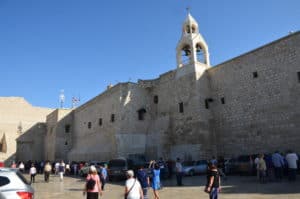Last updated on .
The Church of the Nativity in Bethlehem is one of the most important Christian pilgrimage sites in the Holy Land. It’s traditionally considered to be the birthplace of Jesus.

History
The Church of the Nativity was originally commissioned by Constantine the Great and built between 330 and 333. It was destroyed around 529 and rebuilt by Justinian I. Over the years, it has been repaired and the complex has been expanded.
The Church of the Nativity is the oldest place continuously used as a place of worship in Christianity. The complex covers an area of 12,000 square meters and includes monasteries belonging to the Greek Orthodox, Armenian Apostolic, and Roman Catholic churches. It was named a UNESCO World Heritage site in 2012.
Door of Humility
The entrance is through a low door called the Door of Humility. It’s followed by a set of large wooden doors.
Nave
The Church of the Nativity is maintained by the Greek Orthodox Patriarchate of Jerusalem. There are 44 columns separating the nave from two aisles. Some are painted with images of saints.
On the walls above the columns are the remains of golden Byzantine mosaics. They once decorated both sides of the nave but many sections have been lost to different factors over the centuries.
Sections of the original floors are still intact. If you look down beneath a few sections of the floorboards that have been opened up, you’ll see the beautiful Roman mosaic floors dating back to Constantine’s church.
Chancel
During our visit, the queues to see the birthplace of Jesus were about two hours long. Our guide, Archbishop Aristovoulos of Madaba, went up to speak to a few of the priests and got us into the chancel. We were able to see the Church of the Nativity from a unique perspective.
At the time of our visit, the iconostasis was under restoration and completely covered. The present iconostasis dates back to 1764.
Grotto of the Nativity
After waiting for sometimes several hours, pilgrims can enter the Grotto of the Nativity through the south transept. The grotto is underneath the altar of the church. Unfortunately, we literally had only a few seconds to visit. We weren’t allowed to take any photos, and if anyone was taking too long, a priest would hurry them out.
Inside the Grotto of the Nativity, there’s a niche with a 14-pointed silver star indicating the exact birthplace of Jesus. It was installed by the Catholics in 1717, removed allegedly by the Greeks in 1847, and replaced by the Ottoman government in 1853. A hole in the middle of the star allows pilgrims to reach down and touch the stone the Virgin Mary laid on to give birth to Jesus.
The Altar of the Nativity is controlled by the Greek Orthodox and Armenian Apostolic churches while the Roman Catholic church controls the Grotto of the Manger. The Grotto of the Manger is where the Virgin Mary laid down the newborn baby Jesus.
Crypt
Next, we walked out from the doors of south transept to the Greek Orthodox Courtyard. This is where the Greek Orthodox monastery is located. It’s administered by the Greek Orthodox Patriarchate of Jerusalem.
Stairs lead down into the Greek Orthodox crypt underneath the church. The crypt contains a cave with the bones of infants killed by Herod on display.
Other sections of the crypt contain several tombs covered by stones as well as loose bones. There’s also the tomb of a saint but I don’t remember who. Finally, if you look closely, you’ll notice crosses carved into the walls by Crusaders and pilgrims over the centuries.
Franciscan Courtyard
From there, we walked back into the Church of the Nativity and exited through cloister of the Franciscan Courtyard. Near the exit, there’s a sculpture of St. George slaying the dragon.